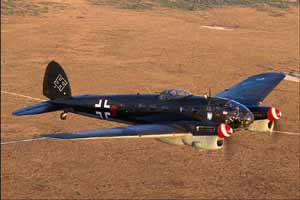Heinkel He 111H (CASA 2111)
German Medium Bomber
 |
The Ghost Squadron's He 111. Image source: The Confederate Air Force Ghost Squadron CD-ROM produced by Corel. Photos by Bill Crump. |
One of the best known and most widely used German bombers of World War II, the Heinkel He 111 was first displayed to the public on 10 January, 1936, ostensibly as a ten-passenger commercial airliner. However, it was a dual purpose design, also aimed at satisfying the newly organized Luftwaffe’s needs for a fast medium bomber.
By mid-1935, the first He-111A bomber variants had entered production, powered by two BMW engines, but the low power of these engines resulted in the Luftwaffe’s refusal to accept them. Thus, ten He 111As were sold to the Chinese government, to help raise much needed hard currency for Germany.
Subsequent versions were engined with either Daimler-Benz DB 600 or Junkers Jumo 211 series liquid-cooled inverted V-12 engines. The He 111 saw its first combat with the Condor Legion in Spain in 1937, where they proved fast enough to evade most of the fighters trying to attack them. This, and other experiences, lead the Luftwaffe to believe it could operate fast medium bombers against any country, without having to provide them with fighter escorts.
This tactic worked during the Blitzkrieg, the lightening war into France, but failed miserably in the fall of 1940, during the Battle of Britain. The He 111P and H models were primarily used in the attacks on England, the H model going on to become the most important variant of the design produced.
The He 111H-6 was typical of the series, but its two or three gunners firing hand-operated light machine guns proved no match for the fast and maneuverable Spitfires and Hurricanes which rose to defend Britain. The Germans quickly learned that they had to provide fighter escorts, usually Bf 109s, for the bombers, but the short range of the fighters limited them to only about ten minutes endurance over Britain.
The Spanish firm CASA built 200 He 111H-16s under license from Heinkel, beginning in 1945, powering them with British Merlin engines. The CASA 2111s continued in service with the Spanish Air Force as transports until the late 1960s, and were used in the filming of the movie The Battle of Britain in 1967. The CAF He 111 is the only one regularly flying in the world today.
The Spanish Heinkel 111s
During World War II, Spain purchased the rights to manufacture the He 111H as CASA 2111s. However, the Spanish equipped their version with British Merlin engines, in place of the German Jumo 211s. Many were built as transports, without bombing equipment. They served into the 1960s with the Spanish Air Force and are the last flying examples of the design.
Note: The CAF He 111 was destroyed when an engine failed on approach to landing while enroute to an air show in July 2003. Look here to view the official press release.
Specifications (data for He 111H-6)
Normal Crew of Four to Six Two Junkers Jumo 211F Engines Seven 7.9mm Machine Guns Max. Speed 258 mph @ 16,400 feet |
Climb to 13,000 ft in 16.8 minutes Length 54' 6" Max. Weight 27,400 lbs Normal Range 760 miles |